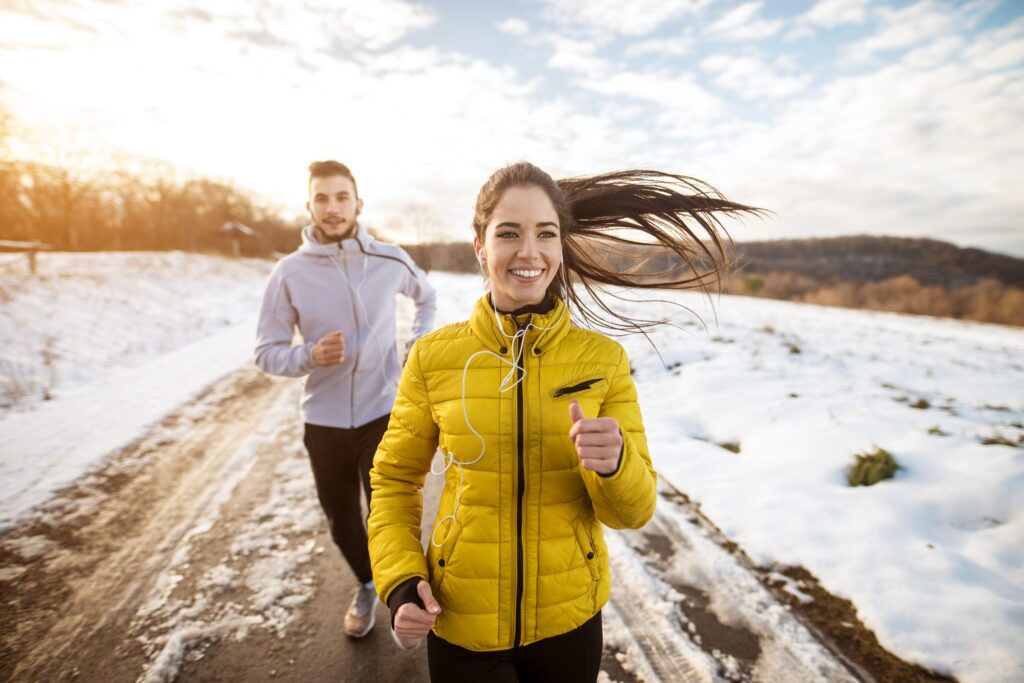Medical Review by Jennie Stanford, MD, FAAFP, DABOM
Summary
- Winter’s shorter days and cold weather provide an opportunity to focus on health goals, like regular exercise and healthy eating.
- Reduced sunlight during winter can trigger seasonal affective disorder (SAD), leading to mood changes, oversleeping, and trouble concentrating.
- Cold temperatures reduce muscle and joint inflammation while activating brown fat, which helps burn calories and supports weight management.
- Eating warming nutrient-rich foods and engaging in regular exercise strengthens your immune system.
Winter comes with challenges & opportunities to improve your health
Winter brings shorter days, colder weather, and natural changes in how you may feel and act. With shorter daylight hours, your body responds to the season in noticeable ways. Light plays a big role in this—it affects your mood, alertness, sleep, and ability to think clearly. For some, these changes can lead to seasonal affective disorder (SAD).
But it’s not all bad news! Winter also gives you a chance to focus on building routines and making meaningful, lasting changes. Whether it’s creating a consistent sleep schedule, starting a new workout plan, or focusing on eating well, winter allows you to set goals and stick with them.
By understanding how winter impacts your health, you can use it to your advantage—and we’re here to help guide you along the way. We’ll also tell you more about when to reach out to a healthcare provider for help with SAD so you can take care of your mental health during this often stressful time of year.
Winter’s surprising seasonal health benefits
Reduced inflammation
Cold weather can work wonders for your body, especially when it comes to reducing inflammation. For centuries, people have used cold therapy—known as cryotherapy—for health, recovery, and injury treatment.
Cryotherapy includes several techniques designed to lower tissue temperatures and improve blood flow. Some examples include:
- Cold water immersion
- Ice therapy
- Exposure to cold air
The benefits of cold exposure include easing muscle and joint stiffness and pain, as well as reducing muscle damage from workouts.
Increased calorie burn
Your body has a special type of fat called brown fat (BAT) that helps keep you warm when it’s cold. Brown fat burns calories at a higher rate to produce heat, which helps maintain your core body temperature.
Because it increases energy use, some evidence suggests that exposing yourself to cold could help with weight management by potentially reducing body fat over time. However, this evidence is not conclusive.
Overcoming winter-specific health challenges
Seasonal affective disorder (SAD)
When the days get shorter in fall and winter, you might feel more tired, have trouble focusing, or notice your mood drop. This could be linked to seasonal affective disorder (SAD), a type of depression tied to changes in daylight. The lack of sunlight can disrupt your body’s internal clock, called your circadian rhythm, which affects your energy and mood.
SAD symptoms can include common signs of depression like feeling low or unmotivated, as well as specific symptoms of SAD, like oversleeping, overeating, and withdrawing from social activities. Learn more about the most common symptoms of seasonal affective disorder and when to seek professional help.
While the exact causes of SAD are still being studied, factors like reduced sunlight, changes in brain chemicals, sensitivity to light, and even genetics can all play a role.
Combating SAD
There are many options to tackle SAD and feel better during the darker months.
- Light therapy uses a special lightbox that mimics natural sunlight and boosts your mood.
- Medications like SSRIs or FDA-approved bupropion can also help manage symptoms.
- Cognitive-behavioral therapy (CBT) focuses on shifting negative thoughts linked to winter and encourages mood-boosting activities. These options can make a big difference in how you feel and help you stay on top of your mental health.
Appropriate medical support can be important for dealing with SAD. Left untreated, this disorder has the potential to affect both your mental and physical health. Early treatment can help you manage your symptoms better and improve your quality of life.
Read more: Understanding seasonal affective disorder: causes, symptoms, & treatment options
Your winter diet
As temperatures drop, choosing the right foods can help your body stay warm and support your overall health. Warming foods and drinks do more than just warm you up—they also help improve digestion, making it easier for your body to break down and absorb nutrients.
Nutrition plays a key role in supporting your immune system. A balanced diet gives your body the fuel it needs to function, helping immune cells work at their best. Nutrients like vitamins A, C, and D, as well as zinc, iron, and copper, are essential for immune health.
Eating healthy foods, like fruits, vegetables, lean proteins, low-fat dairy, and whole grains, can also help. These foods provide the nutrients you require for a strong immune system and may help protect you against illness.
Exercise and immune health
Exercise strengthens your immune system in multiple ways. It helps clear bacteria from your lungs and airways, lowering the chances of getting sick. It also increases blood flow, circulating antibodies and white blood cells faster to detect and fight infections earlier. Moderate activity, even for under an hour, activates immune cells, improves circulation of helpful immune components, and keeps stress hormones low.
Winter doesn’t have to slow you down—outdoor and indoor activities both offer benefits. A winter sports study even found that exercise outdoors reduced airway inflammation in people with asthma and allergies. Just remember, balance is key—overdoing it can have the opposite effect.
Tips for success
Get active at home
Adults need at least 150 minutes of moderate-intensity physical activity a week—just 30 minutes a day, 5 days a week. Get in a mix of aerobic exercise, like walking or running, and muscle-strengthening activities for overall health.
Plan your meals
Meal prepping with nutrient-rich ingredients ensures you’re eating balanced meals. Focus on whole grains, lean proteins, and fresh produce to support energy levels and overall health.
Get support
If you’re struggling to take care of your health this winter, get professional support. Lemonaid Health offers guidance, monitoring, and options for medication, including weight loss solutions when needed.
Read more: The ultimate guide to Wegovy®: uses, benefits, side effects & more
Get your health back on track this winter with Lemonaid Health
Winter offers unique health benefits, such as reducing inflammation and burning calories, while also providing the perfect opportunity to establish new habits and routines. While challenges like seasonal affective disorder may arise, understanding its symptoms and seeking support can help you overcome them. Working with a qualified healthcare professional is the best way to develop a safe and effective personalized plan to stay healthy during the colder months.
Our team at Lemonaid Health can help. Find support with a qualified US-based health professional who can help you understand your symptoms and find appropriate solutions—including FDA-approved medication in clinically indicated cases.
Wegovy® is a registered trademark of Novo Nordisk A/S.












